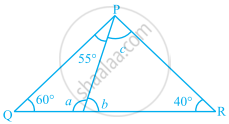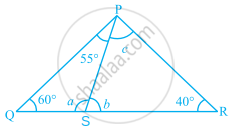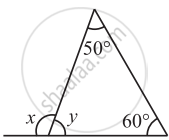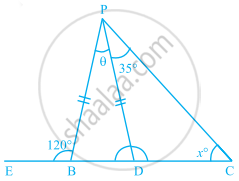Advertisements
Advertisements
Question
In the given figure, find the values of a, b and c

Solution

In figure,
In ΔPQS, ∠QPS = ∠PQS + ∠PSQ = 180° ......[Sum of all the angles of a triangle is 180°]
⇒ 55° + 60° + a = 180°
⇒ 115° + a = 180°
⇒ a = 180° – 115° = 65°
Now, a + b = 180° ......[Linear pair has sum of 180°]
⇒ 65° + b = 180°
⇒ b = 180° – 65° = 115°
In ΔPSR, ∠PSR = ∠SPR + ∠PRS = 180° ......[Sum of all the angles of a triangle is 180°]
⇒ 115° + c + 40° = 180°
⇒ 155° + c = 180°
⇒ c = 180° – 115° = 25°
APPEARS IN
RELATED QUESTIONS
Find the value of the unknowns x and y in the following diagram:

Find the value of the unknown x and y in the following diagram:

Can a triangle have two obtuse angles? Give reason for your answer.
In an isosceles triangle, one angle is 70°. The other two angles are of ______.
- 55° and 55°
- 70° and 40°
- any measure
In the given option(s) which of the above statement(s) are true?
In the given figure, PB = PD. The value of x is ______.

If one angle of a triangle is equal to the sum of other two, then the measure of that angle is ______.
The sum of the measures of three angles of a triangle is greater than 180°.
It is possible to have a triangle in which each angle is greater than 60°.
In a triangle ABC, the measure of angle A is 40° less than the measure of angle B and 50° less than that of angle C. Find the measure of ∠A.
The angles of a triangle are arranged in descending order of their magnitudes. If the difference between two consecutive angles is 10°, find the three angles.
